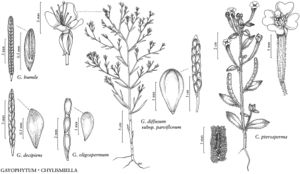Chylismiella
Syst. Bot. Monogr. 83: 115. 2007.
| Taxon | Illustrator ⠉ | |
|---|---|---|
 | Gayophytum humile Gayophytum decipiens Gayophytum oligospermum Gayophytum diffusum subsp. parviflorum Chylismiella pterosperma |
Herbs, annual, caulescent; from a taproot. Stems erect, branched. Leaves cauline, alternate; stipules absent; petiolate; blade margins entire. Inflorescences racemes, nodding at anthesis, erect in fruit. Flowers bisexual, actinomorphic, buds erect; floral-tube deciduous (with sepals, petals, and stamens) after anthesis, nectary unknown, presumably at base of tube; sepals 4, reflexed singly or in pairs; petals 4, white, yellow at base, fading purple; stamens 8 in 2 subequal series, anthers basifixed, pollen shed singly; ovary 4-locular, stigma subentire or slightly lobed, subcapitate, surface unknown, probably wet and non-papillate. Fruit a capsule, straight or slightly curved, terete, loculicidally dehiscent; pedicellate. Seeds numerous, in 2 rows per locule, (appearing as 1 by crowding), with thick wing on concave side, wing and convex side covered with glassy, clavate hairs. = 7.
Distribution
w United States
Discussion
Species 1.
Chylismiella was formerly included as a section in Oenothera (P. A. Munz 1928; P. H. Raven 1962, 1964) or Camissonia (Raven 1969), and elevated to generic rank based on molecular analyses of the Onagreae. Chylismiella was placed by R. A. Levin et al. (2004) sister to Gayophytum rather than with other groups placed by Raven (1964, 1969) in Camissonia. Chylismiella plus Gayophytum together have a sister relationship to Clarkia in the Levin et al. analyses. Raven (1969), in noting that Chylismiella pterosperma (as Camissonia) is extremely distinctive and not closely allied to other groups in Camissonia, suggested the possibility of a close relationship between Chylismiella and Gayophytum due to the shared character of white petals with a yellow band near the base, but did not suggest a close relationship with Clarkia. Chylismiella is distinguished by seeds with thick, papillate wings. Reproductive features include: self-compatible and flowers diurnal, mainly autogamous (Raven 1962, 1969).
Selected References
None.